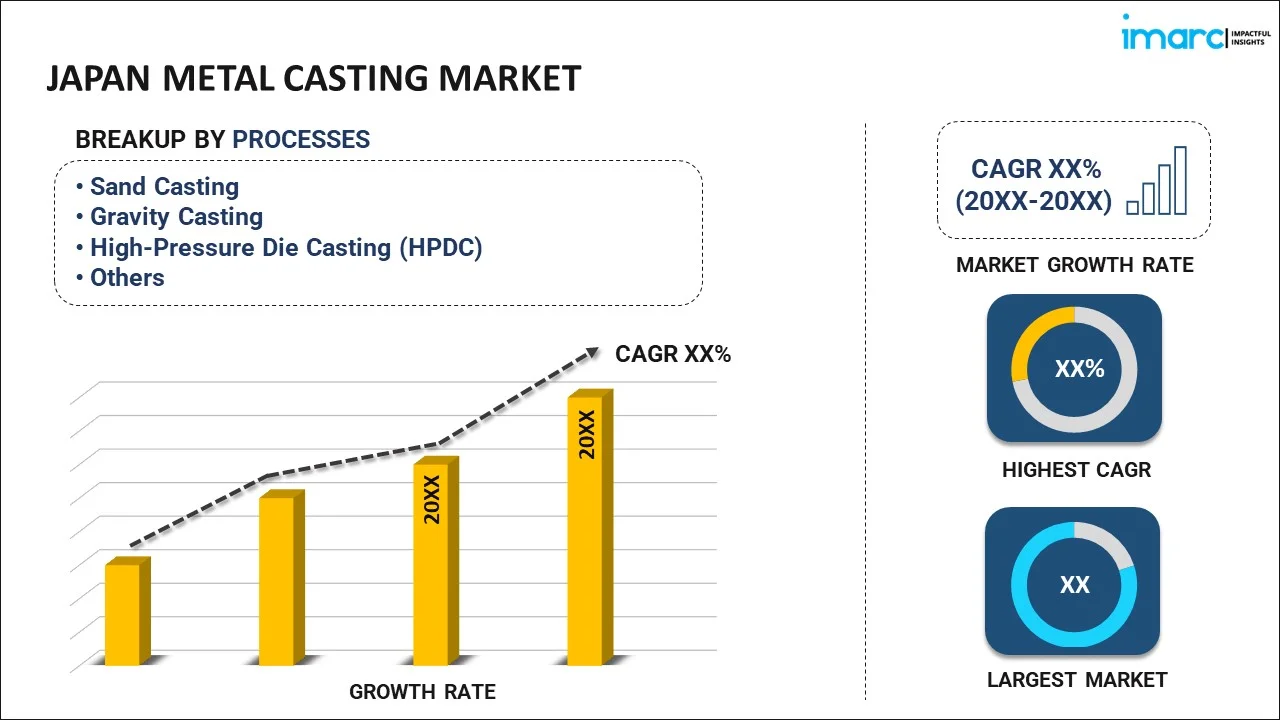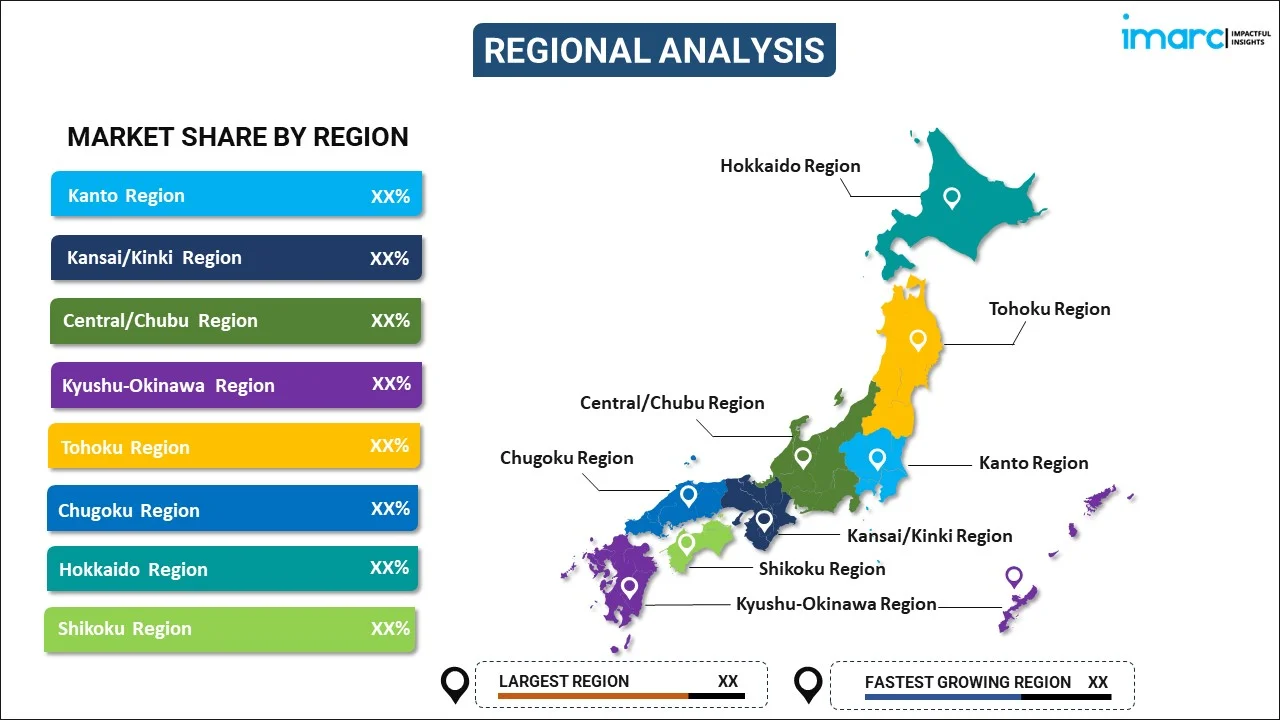
Japan Metal Casting Market Report by Process (Sand Casting, Gravity Casting, High-Pressure Die Casting (HPDC), Low-Pressure Die Casting (LPDC), and Others), Material Type (Cast Iron, Aluminum, Steel, Zinc, Magnesium, and Others), End Use (Automotive and Transportation, Equipment and Machine, Building and Construction, Aerospace and Military, and Others), and Region 2025-2033
Market Overview:
Japan metal casting market size reached USD 10,484.5 Million in 2024. Looking forward, IMARC Group expects the market to reach USD 22,762.2 Million by 2033, exhibiting a growth rate (CAGR) of 9% during 2025-2033. The implementation of strict regulations by government bodies to reduce emission levels in power plants is primarily driving the market growth.
|
Report Attribute
|
Key Statistics
|
|---|---|
|
Base Year
|
2024
|
|
Forecast Years
|
2025-2033
|
|
Historical Years
|
2019-2024
|
|
Market Size in 2024
|
USD 10,484.5 Million |
|
Market Forecast in 2033
|
USD 22,762.2 Million |
| Market Growth Rate 2025-2033 | 9% |
Metal casting is a manufacturing procedure where molten metal is poured into a mold and allowed to solidify into the desired shape. The process entails several steps, such as pattern making, mold creation, pouring, solidification, and finishing. Various metals, including iron, steel, aluminum, copper, and zinc, can be utilized in this method. While it is a intricate process demanding skilled professionals and meticulous attention to detail, metal casting proves instrumental in producing high-quality metal products. Its applications are diverse, ranging from automotive parts and machinery components to tools and decorative items. The advantages of metal casting extend to improvements in energy efficiency, reduction in production costs, enhancement of environmental quality, and the creation of innovative cast products.
Japan Metal Casting Market Trends:
Metal casting plays a crucial role in the Japanese market, particularly in the automotive industry, where it is utilized for crafting various components like engine blocks, cylinder heads, crankshafts, transmission cases, gears, control arms, rotors, calipers, and fuel-related elements such as pumps and injectors. This significance is further emphasized by the increasing adoption of luxury, hybrid, and electric vehicles (EVs) due to rapid urbanization and rising income levels. Additionally, the construction sector in Japan also leverages metal casting for the production of building components like door handles, hinges, locks, balusters, railings, and staircases, utilizing materials such as brass, iron, or aluminum. This trend aligns with the growth in construction activities observed in both residential and commercial areas, which is acting as another significant growth-inducing factor. Furthermore, the market experiences positive influence from the demand for renewable energy sources like wind turbines and solar panels, necessitating metal casting for various components. Apart from this, metal casting finds extensive application in the manufacturing of aircraft, home appliances, and surgical equipment, benefiting from its diverse advantages such as enhancing energy efficiency, reducing production costs, and elevating product quality. The multifaceted applications of metal casting will contribute significantly to its growth in the Japanese market over the forecasted period.
Japan Metal Casting Market Segmentation:
IMARC Group provides an analysis of the key trends in each segment of the market, along with forecasts at the country level for 2025-2033. Our report has categorized the market based on process, material type, and end use.
Process Insights:

- Sand Casting
- Gravity Casting
- High-Pressure Die Casting (HPDC)
- Low-Pressure Die Casting (LPDC)
- Others
The report has provided a detailed breakup and analysis of the market based on the process. This includes sand casting, gravity casting, high-pressure die casting (HPDC), low-pressure die casting (LPDC), and others.
Material Type Insights:
- Cast Iron
- Aluminum
- Steel
- Zinc
- Magnesium
- Others
A detailed breakup and analysis of the market based on the material type have also been provided in the report. This includes cast iron, aluminum, steel, zinc, magnesium, and others.
End Use Insights:
- Automotive and Transportation
- Equipment and Machine
- Building and Construction
- Aerospace and Military
- Others
The report has provided a detailed breakup and analysis of the market based on the end use. This includes automotive and transportation, equipment and machine, building and construction, aerospace and military, and others.
Regional Insights:

- Kanto Region
- Kansai/Kinki Region
- Central/ Chubu Region
- Kyushu-Okinawa Region
- Tohoku Region
- Chugoku Region
- Hokkaido Region
- Shikoku Region
The report has also provided a comprehensive analysis of all the major regional markets, which include Kanto Region, Kansai/Kinki Region, Central/ Chubu Region, Kyushu-Okinawa Region, Tohoku Region, Chugoku Region, Hokkaido Region, and Shikoku Region.
Competitive Landscape:
The market research report has also provided a comprehensive analysis of the competitive landscape. Competitive analysis such as market structure, key player positioning, top winning strategies, competitive dashboard, and company evaluation quadrant has been covered in the report. Also, detailed profiles of all major companies have been provided.
Japan Metal Casting Market Report Coverage:
| Report Features | Details |
|---|---|
| Base Year of the Analysis | 2024 |
| Historical Period | 2019-2024 |
| Forecast Period | 2025-2033 |
| Units | Million USD |
| Scope of the Report | Exploration of Historical Trends and Market Outlook, Industry Catalysts and Challenges, Segment-Wise Historical and Future Market Assessment:
|
| Processes Covered | Sand Casting, Gravity Casting, High-Pressure Die Casting (HPDC), Low-Pressure Die Casting (LPDC), Others |
| Material Types Covered | Cast Iron, Aluminum, Steel, Zinc, Magnesium, Others |
| End Uses Covered | Automotive and Transportation, Equipment and Machine, Building and Construction, Aerospace and Military, Others |
| Regions Covered | Kanto Region, Kansai/Kinki Region, Central/ Chubu Region, Kyushu-Okinawa Region, Tohoku Region, Chugoku Region, Hokkaido Region, Shikoku Region |
| Customization Scope | 10% Free Customization |
| Post-Sale Analyst Support | 10-12 Weeks |
| Delivery Format | PDF and Excel through Email (We can also provide the editable version of the report in PPT/Word format on special request) |
Key Questions Answered in This Report:
- How has the Japan metal casting market performed so far and how will it perform in the coming years?
- What has been the impact of COVID-19 on the Japan metal casting market?
- What is the breakup of the Japan metal casting market on the basis of process?
- What is the breakup of the Japan metal casting market on the basis of material type?
- What is the breakup of the Japan metal casting market on the basis of end use?
- What are the various stages in the value chain of the Japan metal casting market?
- What are the key driving factors and challenges in the Japan metal casting?
- What is the structure of the Japan metal casting market and who are the key players?
- What is the degree of competition in the Japan metal casting market?
Key Benefits for Stakeholders:
- IMARC’s industry report offers a comprehensive quantitative analysis of various market segments, historical and current market trends, market forecasts, and dynamics of the Japan metal casting market from 2019-2033.
- The research report provides the latest information on the market drivers, challenges, and opportunities in the Japan metal casting market.
- Porter's five forces analysis assist stakeholders in assessing the impact of new entrants, competitive rivalry, supplier power, buyer power, and the threat of substitution. It helps stakeholders to analyze the level of competition within the Japan metal casting industry and its attractiveness.
- Competitive landscape allows stakeholders to understand their competitive environment and provides an insight into the current positions of key players in the market.
Need more help?
- Speak to our experienced analysts for insights on the current market scenarios.
- Include additional segments and countries to customize the report as per your requirement.
- Gain an unparalleled competitive advantage in your domain by understanding how to utilize the report and positively impacting your operations and revenue.
- For further assistance, please connect with our analysts.
 Inquire Before Buying
Inquire Before Buying
 Speak to an Analyst
Speak to an Analyst
 Request Brochure
Request Brochure
 Request Customization
Request Customization




.webp)




.webp)












